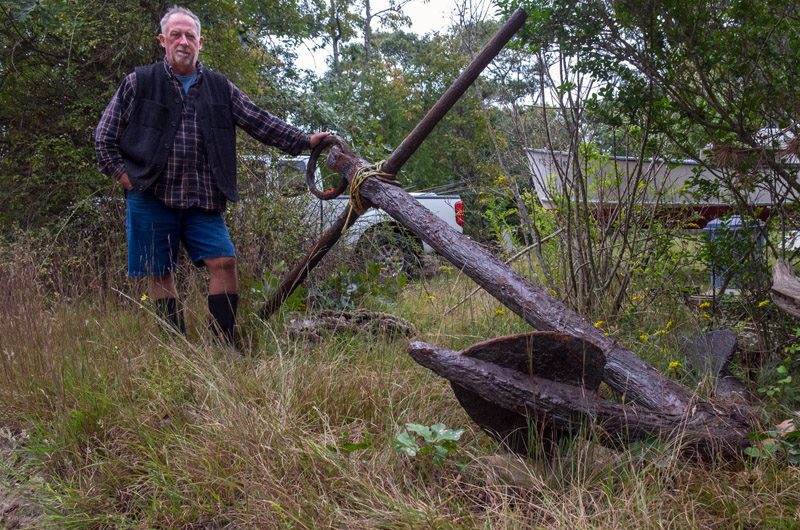Colonel Arthur Metcalf was a particular character on the Vineyard, a place known for its characters. An aeronautical engineer, electronics industrialist and chairman emeritus of the Boston University board of trustees, Mr. Metcalf was a regular summer visitor, often seen sailing into the harbor with full sails and in full nautical dress. Edgartown dockbuilder Steve Ewing still remembers him well.
“He always wore a cap with scrambled eggs [slang for embroidered embellishments] on the brim,” Mr. Ewing said, while standing next to another memento from Mr. Metcalf, who died in 1997 — a 4,000-pound naval anchor.
The anchor was unearthed last week by Mr. Ewing from the Edgartown Harbor, along with its buddy, a 1,000-pound fisherman’s anchor. The two titans were part of a mooring Mr. Metcalf had built nearly 50 years ago.
Mr. Metcalf had previously lost a sailboat in a hurricane when it was moored off-Island. He didn’t want to lose a second boat and so when he planned a mooring for his new boat Veritas in the Edgartown Harbor, he wanted to make sure it was a strong one. He began corresponding with Philip Norton of Norton & Easterbrooks. In an exchange of letters in January and February of 1969, the two men worked out the details.
“As you may know, I lost one of the most beautiful 12-metre sloops at Marblehead in hurricane Carol merely because the upper part of the mooring was a Manila hawser which, after five hours, from 7 a.m. to noontime, when the wind reached 105 mph, parted at the waterline,” Mr. Metcalf wrote, describing the depth of his desire for a strong mooring.
Mr. Norton sent back two diagrams; one with three 4,000-pound blocks and the other with a 4,000-pound block held in place by two 2,000-pound mushroom anchors. Mr. Norton stressed that the blocks would not be as heavy underwater.
“Three 4,000-pound blocks will only weigh about 2,350 pounds each after they are submerged in water, for a total of about 7,000 pounds,” he wrote, while also deferring politely to Mr. Metcalf’s team of Cambridge engineering specialists. “You will have to ask one of your slide-rule men to tell you which will hold more.”
Mr. Metcalf’s reply was unequivocally in favor of a Vineyard man’s water smarts: “I have ten times as much faith in what you consider to be a proper mooring than in any of my slide-rule people up here,” he wrote in a letter dated Jan. 10, 1969.
In the end, they decided on a mooring flanked by two anchors. But instead of using two mushroom anchors, the team opted for a pair of nautical anchors found in Rhode Island and brought back to the Vineyard by Pete Vincent in his flatbed truck, Mr. Ewing recalled. Mr. Norton and Edwin Gentle Jr. then assembled the anchors into the mooring.
Mr. Ewing remembered Mr. Metcalf doing fly-bys in his Mustang plane to see if the mooring was ready.
“He’d buzz around the harbor with it, make sure the mooring was in before he brought the boat down,” Mr. Ewing said.
Mr. Ewing became the caretaker for the mooring, and about 25 years ago, when Mr. Metcalf sold Veritas, he gifted it Mr. Ewing.
Over the years Mr. Ewing has let other sailors use the mooring, and all was well until this winter, when a 105-foot sailboat owned by Nick van Nes was attached. During a storm, the naval anchor was pulled into a standing position. It was now a safety issue for other boats in the harbor and Mr. Ewing decided it was time for the anchors to find new homes on land. He offered the fisherman’s anchor to the Martha’s Vineyard Preservation Trust, thinking it would make a nice addition outside the Carnegie Building. The naval anchor will make its home outside of Mr. Ewing’s shop, unless somebody else wants it, he said.
Back underwater, two 6,000-pound concrete blocks have taken over the anchoring duties at the mooring.





Comments (4)
Comments
Comment policy »